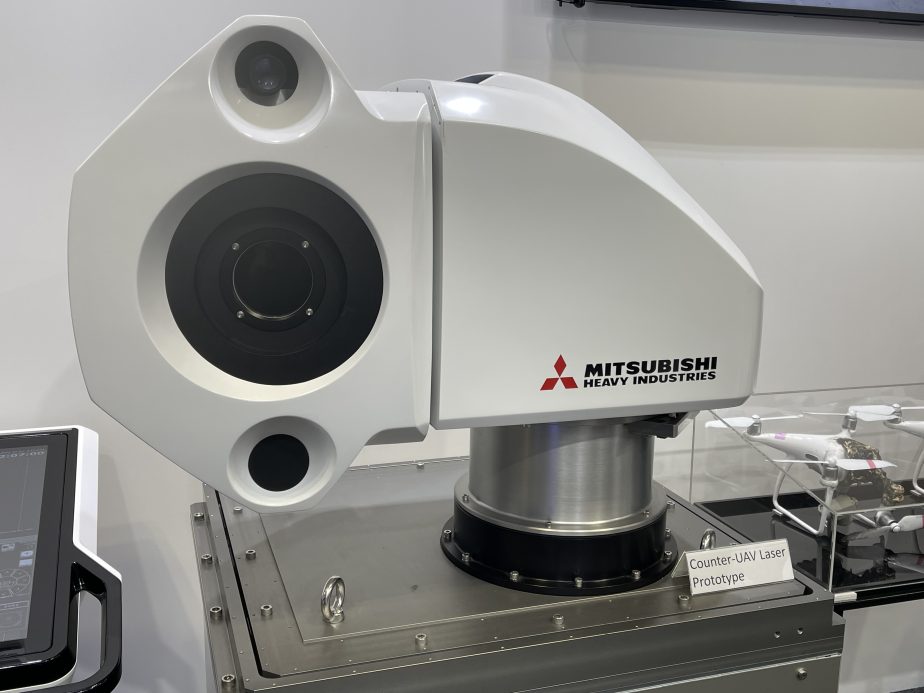For the first time, Mitsubishi Heavy Industries (MHI) and Kawasaki Heavy Industries (KHI) have unveiled in public the prototypes of their respective laser systems to shoot down incoming hostile unmanned aerial vehicles (UAVs).
Displayed at the DSEI Japan 2023 show, which was held in Chiba Prefecture from March 15 to 17, both systems marked a crucial advancement for Tokyo amid concerns that the Chinese military may launch a swarm attack by drones around the disputed Senkaku/Diaoyu Islands and major bases of the Self-Defense Forces (SDF) in case of emergencies in areas surrounding Japan.
MHI officials said that the company has repeatedly conducted outdoor field tests using the prototype of its laser energy-based counter-unmanned aircraft system (C-UAS) on Tanegashima in Kagoshima prefecture, an islet south of Japan’s southernmost main island, for the past two years.
At its booth at DSEI, MHI played a video showing a 10 kW (kilowatt) fiber laser that shoots down a flying drone 1.2 kilometers away in 2 to 3 seconds. MHI officials said the company plans to deliver the prototype to the Japanese Ministry of Defense (MoD) in December.
MHI officials said the C-UAS can be fitted onto ground vehicles for mobility, adding that this system can be used not only by the Ground Self-Defense Force, but also by the land bases of the Maritime and Air Self-Defense Forces.
“Any Self-Defense Force can use it from the ground as long as it is intended to shoot down flying objects,” one MHI official said.
When asked if the system could intercept incoming missiles, one MHI official said, “We haven’t done a high level of research in-house, but I think it is possible by increasing the output [energy].”
In November 2021, based on internal research, MHI signed a contract with the MoD’s Acquisition, Technology, and Logistics Agency (ATLA) to build a research prototype of a vehicle-mounted high-power laser demonstration device. The contract amount was 825 million yen ($6.21 million).

A prototype of Mitsubishi Heavy Industries (MHI)’s new laser system to counter unmanned aerial vehicles (UAVs). Photo by Takahashi Kosuke.
While MHI is developing a vehicle-mounted 10-kilowatt laser system, KHI is developing a more powerful 100-kilowatt vehicle-mounted shoot-down system. As the power output of the laser increases, a large power supply and cooling water circulation systems are required; thus the KHI systems are set to be mounted on a larger, trailer-type vehicle.
The prototype displayed by KHI at DSEI has only a 2-kilowatt laser power. The officials said that the laser in this prototype can eliminate UAV targets up to a range of several hundred meters, and that both the 100-kilowatt and 2-kilowatt laser systems use the same 1 micrometer (1/1,000,000 of a meter) band fiber laser. That means the wavelength of the laser is in the 1 μm band in the near-infrared region.
Kawasaki’s shoot-down system detects the drone with an infrared (IR) camera, then tracks it down, locks onto it, and fires a laser.
KHI officials said that it had delivered one prototype of this C-UAS to the ATLA in February and that evaluation tests will start there from April 2023.
In the 2021 budget, the MoD allocated 2.8 billion yen for demonstration costs of the vehicle-mounted laser system.
“Regarding high-power lasers, which are expected to respond efficiently to future airborne threats, we will utilize the results of our ongoing research on high-power laser systems and demonstrate the implementation of laser systems in vehicles,” the ministry explained in its budget document.
Directed energy weapons (DEWs), which destroy targets by irradiating them with laser-like energy, are said to have significant cost advantages in terms of military defense. For example, the latest interceptor missile SM-3 Block IIA to be installed on the JMSDF’s Aegis-equipped destroyers costs about 4 billion yen per shot. On the other hand, it is said that it costs about $1 or so for electricity to fire a laser weapon. As long as the electricity continues, there is no need to worry about stockpiles of missiles or ammunition.
Moreover, militaries in China, North Korea, Russia, and elsewhere are developing “technologically sophisticated” missiles such as hypersonic ones that could evade existing missile defense systems.
Thus, Japan is pursuing a host of directed energy programs, including systems to shoot down incoming unmanned aerial systems, although a practical, higher-powered missile defense system is still some way off.

































